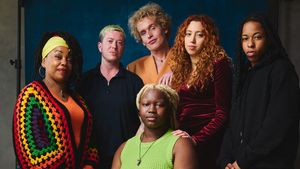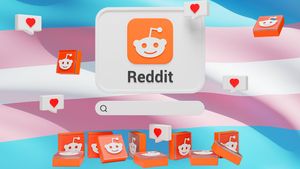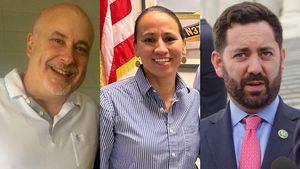Treatment GuideJust DiagnosedSex & DatingAfrican AmericanStigmaAsk the HIV DocPrEP En EspañolNewsVoicesPrint IssueVideoOut 100
CONTACTCAREER OPPORTUNITIESADVERTISE WITH USPRIVACY POLICYPRIVACY PREFERENCESTERMS OF USELEGAL NOTICE
© 2025 Pride Publishing Inc.
All Rights reserved
All Rights reserved
Scroll To Top
By continuing to use our site, you agree to our Privacy Policy and Terms of Use.
Tom Donohue is ordinary. He is a face in the crowd. He is just like everyone else. Talk with the now-26-year-old man for an hour or so and you will hear him make this claim to conventionality some nine or 10 times. It is his mantra. But because he is an HIV-positive youth, it is also his public-health message. Whether this message is powerful enough to reach today's young people raises the thorny question of just what it takes to get a new generation invested in wanting to protect themselves against HIV'or in some cases, what it takes to make them remember the virus exists at all. When the rural Pennsylvania resident and off-and-on college student found out he was HIV-positive in October 2003, his reaction to the news was unusual for someone his age: After about six weeks he started a new life of public speaking about his serostatus. He now runs a fledgling nonprofit organization, Who's Positive, along with its Web site, WhosPositive.com. And there is a billboard along U.S. Route 220 near Lock Haven, Pa., emblazoned with his unassuming face and the words 'My name is Tom'25 years old'HIV-positive'and in your neighborhood. Just like HIV. Have you been tested lately?' Donohue's routine is to show up in a room of college students as they file in and sit among them as if he were one of their peers. A facilitator will announce that someone in the room is HIV-positive, at which point Donohue will jump up and announce in his cheerful style that he is the man in question, thus stressing that HIV could strike any one of them. Over the course of 40 minutes he then tells unscripted stories about his experience. A Q&A session follows. His program is almost entirely social in its approach, with few statistics and little talk of the nitty-gritty of safer-sex techniques. He readily admits that he is 'no expert on HIV,' although he does heavily stress the importance of safer sex and getting tested. Rather, Donohue focuses largely on tapping into young people's fears of having to tell others that they are HIV-positive'ironic, since he has clearly conquered his fear of disclosing his infection by doing so to as many people as possible. Shattering Preconceptions There is further irony in the duality of Donohue's averageness. This John Doe identity serves as a symbol of what led to his infection, and it now is the focus of his prevention message. His everyman mind-set made him believe that HIV would never strike a guy like him, since he lived so far from big cities. Though he had had unprotected anal sex with casual partners, he had no reason to believe his HIV antibody test would come back positive, because he had a vague notion about HIV of gruesome purple Kaposi's sarcoma lesions. When asked what kind of sex education he had in school, he says he cannot recall any. Clearly, whatever was taught did not make an impression. When he is speaking to students, he does not reveal too much personal information. He does not even tell them he is gay, instead simply referring to his former boyfriend as his 'partner,' and he tends not to address the loneliness or isolation he feels. This rhetorical sparseness allows students to use him as a template in their psyches: They put themselves in his place and report coming away with a renewed sense that HIV is no picnic. In truth, Donohue represents a somewhat chilling personification of the ordinary. He is a prototypical example of the failure to get the message to today's youths in time to protect them against HIV. Sex Education Failings According to the CDC, half of all new infections'about 20,000 cases each year'occur in Americans 24 or younger. And a recent study conducted by the Alan Guttmacher Institute found that about 32% of teenage boys do not receive HIV prevention education before the first time they have intercourse, which on average is at 17 for both boys and girls. This year the federal government will spend $167 million on abstinence-only sex education in public schools, more than double what was spent in 2001. A report commissioned by Democratic U.S. representative Henry A. Waxman found that in one of the major national abstinence programs, over 80% of the curricula contained false, misleading, or distorted information. Numerous studies have shown that not only is abstinence-only sex ed ineffective, but its insistence that contraceptives are not to be trusted can lead to riskier sex practices in the long run. On the other hand, scientists widely praise comprehensive sex education'which addresses abstinence as one option in a broader spectrum of sexual choices. Evidence shows this technique delays the onset of sex, increases contraceptive use, and reduces the number of sex partners. Still, according to Guttmacher findings, 35% of U.S. schools offer abstinence-only sex ed, and an additional 51% teach that abstinence is preferred but allow that contraceptives are effective. Only 14% teach comprehensive sex ed. Undoing the damage of imperfect or nonexistent sex ed, along with reminding students that they are at risk, is the task of countless foot soldiers'from those dispatched to college campuses by large organizations (like Planned Parenthood or the National Association of People With AIDS) to solo workers like Donohue. These educators say they have to walk a fine line between encouraging safer sex and fostering unhealthy anxiety about physical intimacy. Fear Factors On the whole, AIDS activists agree that peer education is the most effective tool for reaching youths, since students like to receive health information from someone they can relate to. But Michael McGee, vice president of social marketing at Planned Parenthood, questions Donohue's method of presenting himself as a peer to teens while shying away from the educator role. McGee says such programs can cause excessive anxiety in students by leaving them with a heightened fear of HIV but without enough information on how to keep themselves negative'other than the common 'be safe' and 'get tested' directives. Laura Pinsky runs Columbia University's HIV testing and counseling site, which was the world's first campus organization of its kind when she founded it in 1985. Pinsky says most Columbia students would not bother showing up at an HIV-related event because the issue simply is not pressing enough. So her organization's stance is that education about safer sex requires a deeply psychological, one-on-one approach. The student counselors may spend up to 40 minutes with their clients, discussing not just safer sex but all aspects of human sexuality. Amanda Crosier, who coordinates the program, says that 'there's not a very realistic understanding of HIV' in the students she counsels. 'There are people who are really freaked out about it needlessly.' The testing site's most prevalent demographic is the heterosexual women who have few risk factors for infection'yet they are often plagued by anxiety just the same. On the other hand, Crosier says, young gay men often have the opposite problem. They tend not to have HIV on their radar screens in a meaningful way and are not afraid enough to protect themselves properly. 'The challenge now, from my perspective, is to get my clients not to be afraid of sex'to have a healthy fear of HIV, certainly'but to somehow find the middle ground where they are able to make good decisions,' Crosier says. Donohue disagrees, preferring a more casual approach than one that replicates seeing a psychologist. 'Once we talk abstinence, once we talk statistics, the program becomes not as effective as if we were just peer-to-peer,' he says. 'Once you cross that peer-to-educator line, you start to lose people's attention.'
From our Sponsors
Most Popular
Lexi Love comes out as HIV+ after Trump deletes federal resources
January 23 2025 11:23 AM
Grindr is reminding us why jockstraps are so sexy and iconic
May 02 2025 5:36 PM
BREAKING NEWS: Trump admin moves to end federal HIV prevention programs
March 18 2025 6:10 PM
Trump's orders prompt CDC to erase HIV resources
January 31 2025 5:29 PM
Celebrating Black History Month with our annual African American issue
February 01 2025 3:28 PM
Tyler TerMeer vows to continue to fight for health care for all
January 28 2025 3:00 PM
Discover the power of Wellness in your life
March 26 2025 12:41 PM
Plus: Featured Video
Latest Stories
Dancer. Healer. Survivor. DéShaun Armbrister is all of the above
July 02 2025 8:23 PM
Two right-wing Supreme Court justices signal they may uphold access to PrEP and more
April 21 2025 4:10 PM
Broadway's best raise over $1 million for LGBTQ+ and HIV causes
April 03 2025 7:15 PM
Plus nominated for 2025 GLAAD Media Award
January 22 2025 12:42 PM
'RuPaul's Drag Race' star Trinity K Bonet quietly comes out trans
December 15 2024 6:27 PM
AIDS Memorial Quilt displayed at White House for the first time
December 02 2024 1:21 PM
BREAKING: Supreme Court rules to save free access to preventive care, including PrEP
June 27 2025 10:32 AM
1985: the year the AIDS crisis finally broke through the silence
June 26 2025 11:24 AM
Trump admin guts $258 million in funding for HIV vaccine research
June 03 2025 3:47 PM
500,000 Children at Risk: PEPFAR Funding Crisis
April 08 2025 3:51 PM
The Talk Season 5 premieres this spring with HIV guidance for the newly diagnosed
March 26 2025 1:00 PM
Jess King is here to help you live your happiest, healthiest life yet
March 24 2025 4:35 PM
A camp for HIV-positive kids is for sale. Here's why its founder is celebrating
January 02 2025 12:21 PM
VIDEO: A man living with HIV discusses his journey to fatherhood
June 10 2025 4:58 PM
HRC holds 'die-in' to protest Trump health care cuts
April 28 2025 2:11 PM
Season 4 of The Switch on resilience & radical self-love returns this spring
March 26 2025 12:20 PM
Gerald Garth is keeping people of color happy and healthy through trying times
March 11 2025 3:38 PM
This long-term HIV survivor says testosterone therapy helped save his life.
December 16 2024 8:00 PM
Ricky Martin delivers showstopping performance for 2024 World AIDS Day
December 05 2024 12:08 PM













































































